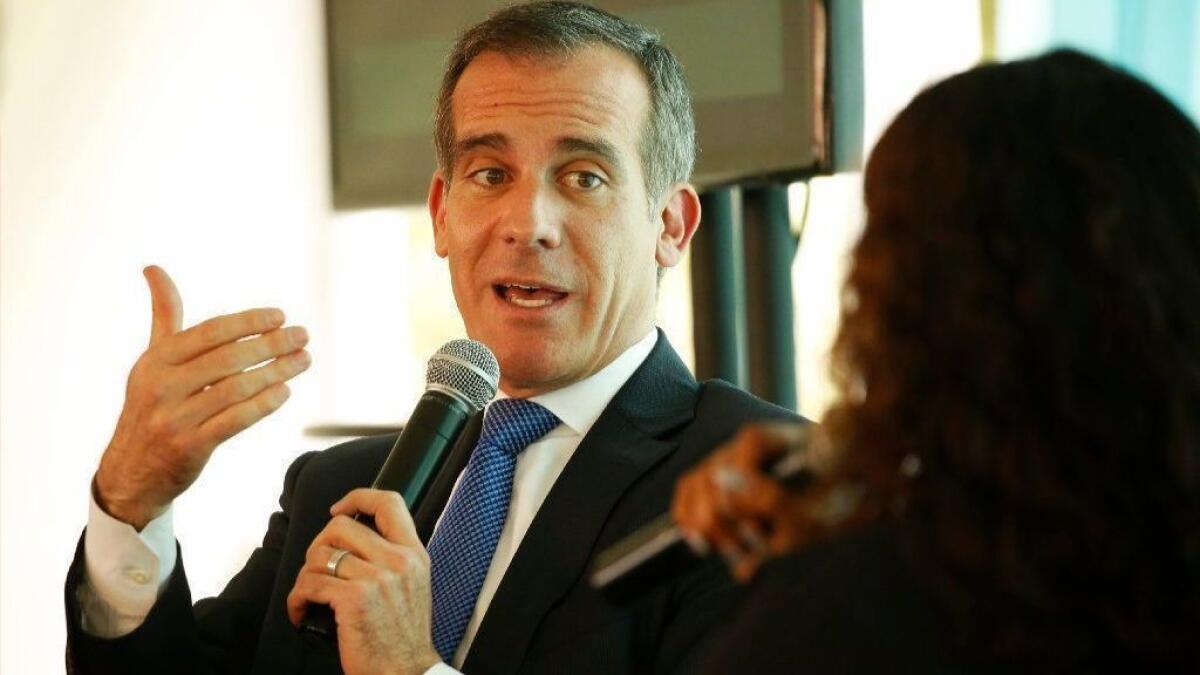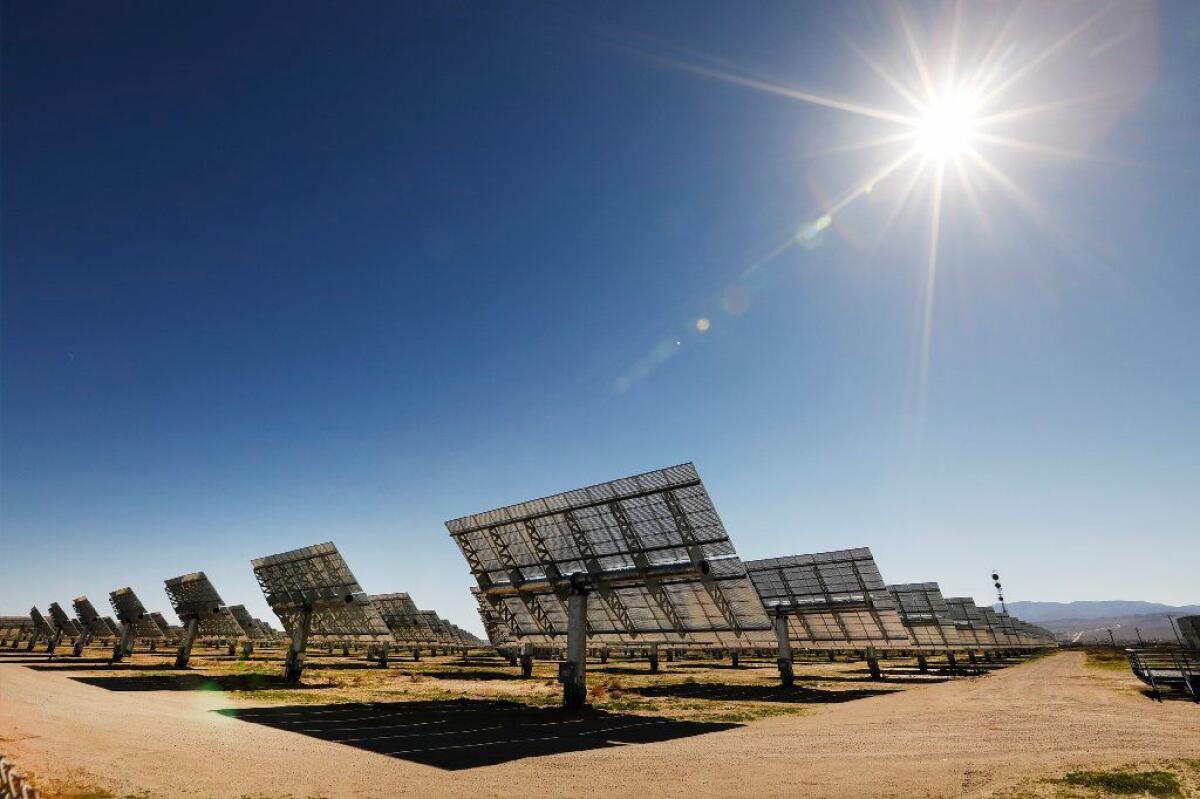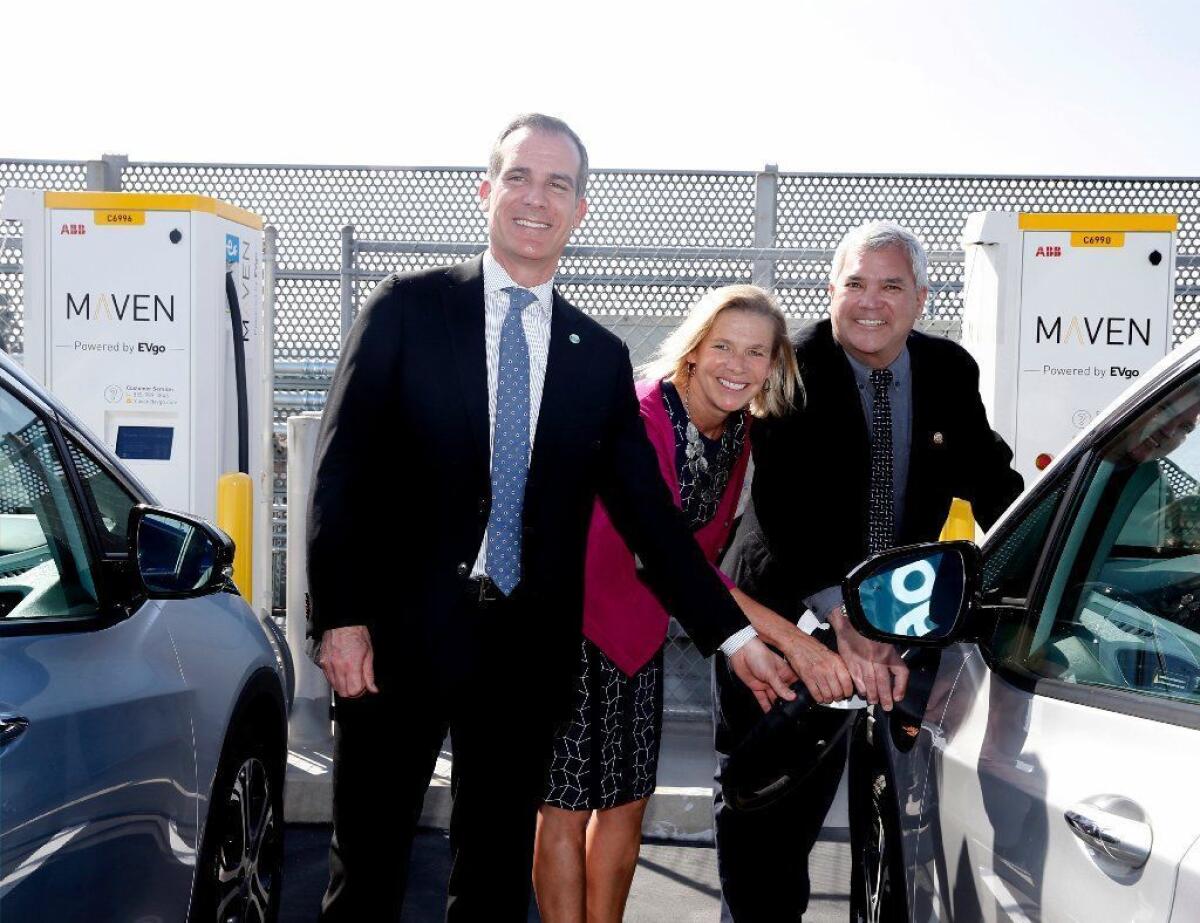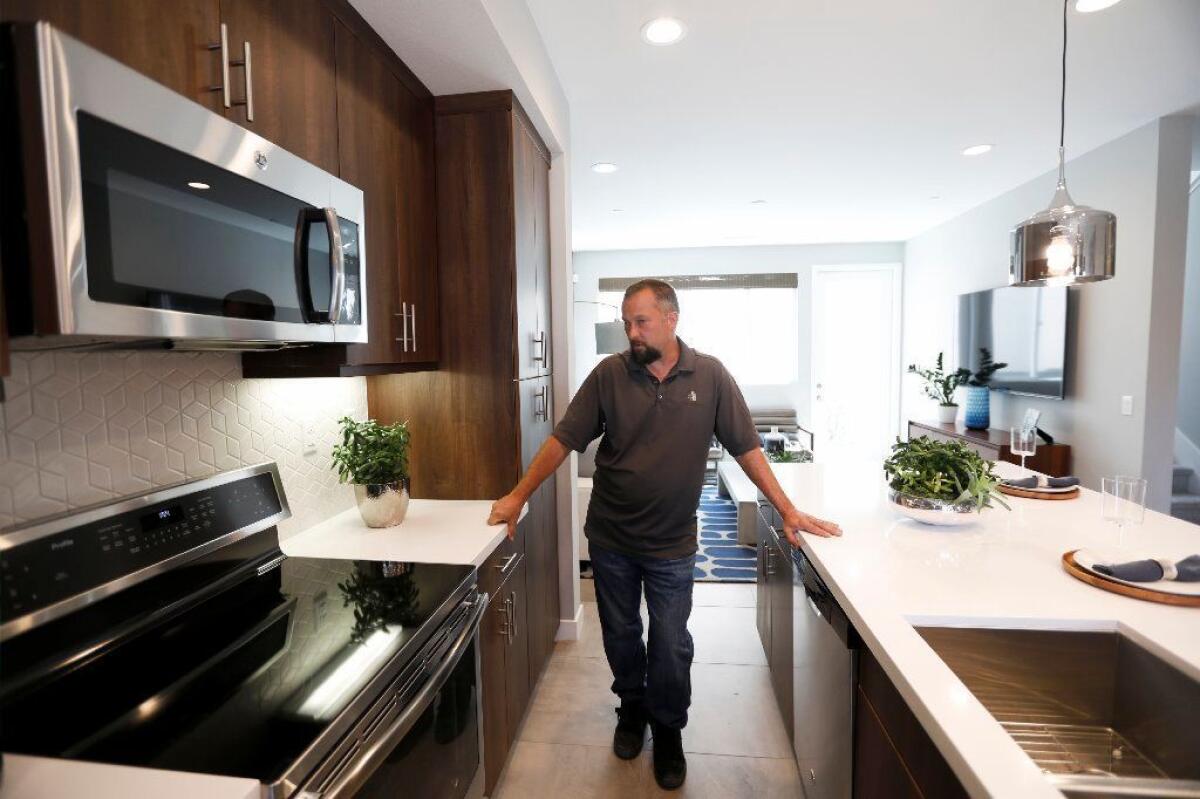L.A. Mayor Garcetti’s ‘Green New Deal’ would phase out gas-fueled cars

Mayor Eric Garcetti unveiled a sweeping plan for a more sustainable Los Angeles on Monday, calling for dramatic changes to the car culture, buildings and air quality of America’s second-largest city.
The mayor’s sustainability plan imagines a city where, by the mid-2030s, 80% of the cars run on electricity or zero-emission fuel, 80% of the electricity comes from renewable sources and Angelenos drive 2,000 fewer miles each year than they do now. It’s a far cry from today’s L.A., where gridlock, tailpipe pollution and smoggy air have come to define a way of life.
Garcetti cited the “existential threat” of climate change, which scientists say is fueling bigger and deadlier heat waves, wildfires and floods in California and around the world. He said he worries that if Los Angeles doesn’t take aggressive action now, in 50 years the city will have little time for priorities other than survival.
“Los Angeles needs to lead, but the whole world needs to act. This plan gives us a fighting chance,” Garcetti said in an interview. “It’s sort of a ‘greenprint’ for every other city in the country and the world, hopefully.”
Garcetti is pitching the plan as L.A.’s version of a Green New Deal, the set of climate change and economic justice policies popularized by progressive activists and championed by Rep. Alexandria Ocasio-Cortez (D-N.Y.).
City Hall may have limited control over whether L.A. meets many of the targets in the plan, which updates a previous sustainability road map from 2015 and has been in the works for several years, before the phrase “Green New Deal” entered the national lexicon.
At times, the plan simply reiterates existing commitments on climate and clean energy, and details for how many of the goals will be achieved are yet to be determined.
But in at least two areas, the plan sets ambitious new targets and lays a foundation for how they might be met: transportation and buildings, which account for three-quarters of the city’s planet-warming emissions.
On the transportation front, the mayor’s office hopes to reduce the amount of time Angelenos spend driving, from an average of 15 miles a day now to 13 miles by 2025, and 9 miles by 2035. More significantly from a climate change emissions standpoint, the sustainability plan calls for increasing the percentage of electric or zero-emission vehicles in the city from 1.4% last year to 25% by 2025, 80% by 2035 and 100% by 2050.
The city’s built environment would see big changes, too. Garcetti’s plan says all new buildings should be “net-zero carbon” by 2030, with the entire building stock converted to zero-emission technologies by 2050.
Even with the falling costs of renewable energy and electric cars, Garcetti said he expects meeting the targets to be “messy and difficult” politically.
The labor union that represents workers at the Department of Water and Power, for instance, recently protested his decision not to rebuild the three coastal gas plants. Union workers protested again Monday outside Garcetti’s house, saying his plan would kill jobs and raise electricity rates.

Garcetti also acknowledged the challenge of getting people to change their behavior, joking that Angelenos “like the way they suffer in their single-passenger, stuck-in-traffic, gas-guzzling cars.”
But Garcetti said he’s hopeful because fighting climate change, expanding the economy and improving people’s quality of life “go hand in hand.” The city’s sustainability plan estimates the creation of 300,000 “green jobs” by 2035, on top of the 35,000 green jobs Garcetti says have already been created since he took office.
“My goal is to build such a strong coalition that the next mayor, the mayor after that, has to accelerate these goals further,” Garcetti said. “There will be pride in this. There will be a sense of who we are.”
Reducing the number of miles people drive could be especially challenging. Garcetti’s plan envisions making it possible largely through initiatives already underway, including a massive build-out of public transit and a proposed “congestion pricing” pilot that would make driving more expensive in some traffic-choked areas.
L.A. takes climate change fight to the streets by pouring cooler pavement »
Getting drivers into zero-emission vehicles also faces hurdles. Choosing a car can be a financially fraught — and intensely personal — decision. But the costs of battery-powered vehicles keep falling, and city officials say they can accelerate the transition to electric cars.
The mayor’s plan sets a target of 28,000 publicly available electric-vehicle chargers by 2028 — up from 2,100 today — with the city streamlining permitting for chargers, expanding rebate programs and requiring more chargers through the building code.
The Department of Water and Power will also develop incentives for customers to buy used electric vehicles, according to Lauren Faber O’Connor, the city’s chief sustainability officer, who helped craft the mayor’s plan.
“We know that the secondary market is really important to proliferate the adoption of EVs,” she said.

The plan also mentions self-driving cars, saying the city should “ensure all autonomous vehicles (AVs) used for sharing services will be electric by 2021.”
Garcetti expressed high hopes for driverless technology.
“Most people will be primarily getting into autonomous vehicles if we look 20, 30 years out. If we mandate that autonomous vehicles have to be electric, then we will move people into electric vehicles,” he said.
Antonio Bento, an economist who leads USC’s Center for Sustainability Solutions, described the goal of 80% zero-emission cars by 2035 as “overly optimistic” and unlikely to be met. But setting such a lofty target could still do a world of good, Bento said, because it sends a message to the private sector that one of the globe’s most car-dependent cities is moving away from oil as quickly as possible.
“The rest of the world, when it comes to these types of policies, they look at Southern California for guidance,” said Bento, who is working with former Gov. Arnold Schwarzenegger and former state Senate leader Kevin De León on an initiative to help local governments speed the adoption of cleaner transportation options. “What appears to be a policy set by one city could quickly grow to capture a large part of the automobile market.”
Garcetti’s goal of converting all buildings to net-zero technology by 2050 may also be a huge lift. That’s because it could require households, landlords and building owners to replace all gas-powered heating and cooling systems, clothes washers, dishwashers and stoves with electric appliances or cleaner fuels.
California’s next frontier in fighting climate change: your kitchen stove »
But Faber O’Connor, the city’s chief sustainability officer, said eliminating planet-warming carbon emissions from buildings may not be as hard as it sounds. She expects building codes and rebates to do the bulk of the work, with homes and businesses installing electric appliances over time as gas-powered versions break down.
State officials are also beginning to develop policies to electrify buildings, which are collectively responsible for a quarter of California’s greenhouse gas emissions. Those efforts have faced pushback from Southern California Gas Co., which sees electrification as a threat to its business model. The gas company has talked up the benefits of replacing the natural gas in its pipelines with so-called renewable gas or, eventually, hydrogen.
Some researchers agree with SoCalGas that substituting cleaner fuels for gas would be easier and cheaper than swapping out gas for electricity. They include Jack Brouwer, a UC Irvine engineering professor, who has led a project to inject small amounts of hydrogen into the university’s gas pipelines.
“Our policy goals cannot be met without hydrogen, is my view,” Brouwer said in an interview last month.

But most clean energy advocates and a growing number of state policymakers disagree, raising questions about the costs and available supply of renewable gas and hydrogen. In a report last summer, the California Energy Commission described a “growing consensus that building electrification is the most viable and predictable path to zero-emission buildings.”
Faber O’Connor said Los Angeles officials “believe that electric will be the predominant solution, and we will be designing incentives in that direction.”
A study released this month by the consulting firm Energy and Environmental Economics found that newly built all-electric homes in California can save residents $130 to $540 per year, and that the vast majority of single-family homes with gas furnaces and air conditioners would save money by replacing those systems with electric heat pumps.
The study modeled several major cities, including Los Angeles, San Francisco and San Jose. It was funded by three electric utilities: Southern California Edison, the Los Angeles Department of Water and Power and the Sacramento Municipal Utility District.
Switching to electricity is “cost-effective in many situations already, even before the market transformation that’s going to further bring down the costs,” said Pierre Delforge, a senior scientist with the Natural Resources Defense Council, who helped review a draft of the electric utilities’ study. “It doesn’t mean it’s cost-effective everywhere yet. But it’s quite promising, because we’re right at the beginning of that technology adoption.”
Climate change is making us sicker and shortening our lives, doctors say »
Delforge said the zero-carbon building plan announced by Garcetti “seems to be aligned with our climate goals, and it seems to be ambitious, particularly for existing buildings.”
“It means we have 30 years to transition the entire building stock to zero emissions. That’s a challenge, and it’s important to get started now,” he said.
In a sign of how quickly the national dialogue around climate policy is evolving — and of the urgency with which scientists describe the climate crisis — some activists criticized Garcetti’s plan as insufficient.
Sunrise Movement Los Angeles, a part of the national organization pushing for a Green New Deal, released its blunt assessment Monday that Garcetti’s plan “is not a Green New Deal.” The group said maintaining a livable climate depends on achieving net-zero carbon emissions by 2030, much earlier than Garcetti’s 2050 goal.
“Los Angeles is on track to be twenty years too late,” the group said in a written statement.
L.A’s sustainability plan also includes a section on the city’s move to 100% renewable energy, which Garcetti accelerated earlier this year when he announced his intention to shutter three gas-fired power plants along the coast. Other sections of the plan outline strategies for increasing the use of local water resources, reducing air pollution from industrial facilities and the port, and slashing emissions from waste and the food system.
Twiter: @Sammy_Roth
More to Read
Inside the business of entertainment
The Wide Shot brings you news, analysis and insights on everything from streaming wars to production — and what it all means for the future.
You may occasionally receive promotional content from the Los Angeles Times.











